Date: February 7, 2000
Subject: The sun also rises--and burns you
G'day mates,
Hopefully you've all had a chance to digest my previous email. Thanks to all who responded and, remember, my money-back guarantee to respond personally to any personal responses is still on.
Maybe this time I'll go backwards by telling you what I've been up to since arriving in the Land of Oz and then about my travels in Japan. First the most important information, the weather: since I've been in Cairns it's been up to 30 degrees C or so during the day w/ humidity up around 65%. It's also been largely overcast w/ a lot of rain, but that isn't too bad since it keeps the bright sun away. It's still strong enough to burn through the clouds though, as I discovered on Thursday when I was snorkelling on the Great Barrier Reef. The Reef is about 40 - 60 km off the coast of Cairns and the waves were pretty high so it was a pretty rough two and half hour ride out. Fortunately I don't seem to be prone to sea-sickness... The water at the reef was calmer, though, especially as the tide fell. After been given a short lecture on how fragile the reef is and told DON'T TOUCH anything whereupon we donned our masks, goggles and fins and jumped into the sea and saw a whole different world. The sea bottom was almost totally covered in coral--of all shapes and colours--at a depth of maybe five to ten feet below the surface. Occasionally there was a trench in the coral twenty or more feet deep which I dove down into for as long as I could hold my breath and my ears could stand the depth. Once I saw a "reef" (aka white-tipped) shark in one of these trenches but it was "only" three or four feet long and once I got back to the boat the crew said that it was probably more scared of me than I was of it. There were other fish everywhere of all shapes, size and colours from a big blue and purple parrotfish w/ a sharp, beak-like mouth that ate the corral, to bright yellow, almost rectangular shaped, fish that you see in aquariumns, to small schools of flourescent blue fish. Suffice it to say that I enjoyed the snorkelling so much (although I have had to be careful w/ my sunburned back the following day) that I signed up for a four day scuba diving course. Saturday and Sunday I went back to school and learned all the theory about diving, and we also spent a lot of time in the pool learning how to use the equipment. Our class was taught by a transplanted Zimbabwean woman (Zimbabwe being next to Zambia, for the geographically challenged) which was a neat connection for me, while we students came from Poland, Colombia, France, England and Canada, along w/ a token local Australian. The other Canadian on the course is a fellow Torontonian who was my "buddy" (i.e., the person whose air I share in the event that mine runs out) in the pool. Great fun--except the homework. Today I had the first two of my four "open water" dives required for certification on the reef. The first dive was mostly business proving that we could empty our masks of water (look up and exhale through your nose) and take our regulators (i.e., air supplies) in and out of our mouths without incident. The second dive, on a different, more interesting reef, was fantastic since we were just "looking around". Diving gives you a great sensation of floating in a three-dimensional world whereas when snorkelling you're just floating on top of it. Our dive leader gave us a tour of the reef and we dove through trenches beside massive "brain" corral, picked up sea cucumbers from the sea bottom, saw small, vividly orange fish hide from us in stinging anenome, and even saw a small "reef" shark. (It pays to remember that objects underwater appear one third bigger than they really are, as I learned in the course.) It was a great experience simply seeing the fish in their own environment all the while comfortably breathing air from our own. Tomorrow I should complete my final two dives at the end of which I should be a certified diver. Highly recommended.
At the end of the course, probably Wednesday or Thursday, I'm planning on making my way down the coast to Sydney. Hopefully I'll be able to do some surfing en route. That should take at least five days since Sydney is almost 2500 km away. I'm starting to realize that my plans to see the whole of coastal Australia in just over a month may be a little ambitious... Anyway, that leaves me something to do the next time I come.
Now onto my time in the Land of the Rising Sun. Again, a map of Japan will help you follow along.
I flew into Fukuoka (on the southern island of Kyushu) two weeks ago last Friday from Singapore via Hong Kong.
The first thing I noticed was how how cold it was: +2 degrees vs. the 25 degrees I'd left in Singapore.
The second thing was how hideously expensive Japan was, especially after Africa. After spending over $20
on a four minute taxi ride to the train station I then bought a Y5000 (almost $80) ticket for a forty minute
"shinkansen" (i.e., bullet train) ride to the town where Shirley-Anne (henceforth SA) picked me up. By
way of comparison, the first-class ticket for my one and half day train ride from Dar es Salaam, Tanzania,
to central Zambia cost less... The second thing I couldn't help but notice was how few people spoke English
so my communication was mostly limited to smiles and nods. Fortunately I had very precise instructions
(thanks Holly!) on how to get to where SA was waiting for me. Unfortunately it was dark when I was on the
shinkansen but from the return trip I guess that it was doing about 200 km/h. At the other end was SA, a
welcome familiar face. It was nice getting caught up w/ each other's lives on the one hour drive to Hagi
(on the south western part of the central island of Honshu, due west of Hiroshima) in a car which you park
by putting in your pocket. On the trip I discovered some more things about Japan: it is mainly mountains,
which means that the roads are small and twisty (no wonder they make such great sport motorcycles!) and go
over lots of bridges and through lots of tunnels. The highways are also expensive since they're toll-roads.
(The tolls from Hagi to Fukuoka would have cost almost as much as my train ticket.) Roadside vending machines
are ubiquitous dispensing everything from cold drinks (from Coke to Japan's answer to Gatorade,
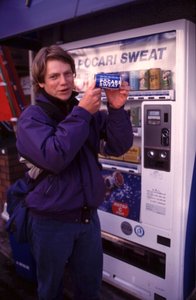 "Pocari Sweat"--I wonder what marketing genius thought that name up; makes you just want to have another
one doesn't it?), to hot drinks (try drinking hot coffee from an aluminum can), to cigarettes, to beer
(where else but Japan would a beer vending machine be safe from vandalism?!) to half a dozen eggs. I kid you not.
It made me wonder how any corner store manages to stay in business.
"Pocari Sweat"--I wonder what marketing genius thought that name up; makes you just want to have another
one doesn't it?), to hot drinks (try drinking hot coffee from an aluminum can), to cigarettes, to beer
(where else but Japan would a beer vending machine be safe from vandalism?!) to half a dozen eggs. I kid you not.
It made me wonder how any corner store manages to stay in business.
SA dropped me off at the church that she attended in Hagi where I was to stay in the guestroom. The first thing I had to do on stepping in the door was master the somewhat elaborate protocol that governs the wearing of shoes outside and which slippers to wear when and where inside. First thing you do on entering a house is take off your shoes just inside the door and put on a size of apparently one-size-fits-all slippers (except me) to wear inside the house. However, these slippers are not to be warn in "tatami" (fine reed?, or split bamboo maybe?, mats) rooms which are the bedrooms and family rooms in traditional Japanese homes. The second exception is the bathroom where another pair of slippers will be waiting for you just inside the door, usually garishly coloured (vs. the typical brown of ordinary slippers) and sometimes helpfully labeled "Toilet" to remind you that you have made a major faux pas if you forget to change them after using the bathroom. The second thing I realized upon stepping into the church was that Japanese buildings do not have central heating, and by this time the temp. was probably around freezing... Rooms in Japanese houses are heated individually w/ kerosene or electrical heaters (which come w/ nifty remote controls). This probably explains why so many older Japanese buildings, built traditionally from wood, burn down. To remind homeowners to turn off their heaters volunteers will wander the streets around bedtime knocking together two bamboo poles and chanting about the dangers of fire. Fortunately the bathroom in the church was in no danger of being set alight by a heater, but those cold tiles woke up my feet in a hurry, the toilet slippers being several sizes too small.
On Saturday SA had to teach some English classes for our cousin Pat (in whose house SA was living) who was in the States for ten days, so after seeing his wife Holly and their two kids, Grace, a blonde two and a half year old whirling dervish, and Sam, four months, and somewhat more placid than his sister, I was shown some of the sites around Hagi by two of Pat and Holly's fellow teachers, Dan and Danika, from Ottawa. Although it's now a relatively small and unimportant city (although it has contributed several of Japan's Prime Ministers), Hagi is very significant historically since that is where the "Meiji Restoration" started which brought about the changes in government that led to the modernization of Japan. Ironically Hagi's main attractions are the feudal ruins that predate the Meiji Restoration and it has many pretty little (Shinto) shrines and (Buddhist) temples, plus the remains of the castle walls. (The castle itself was destroyed in the Restoration.) Particularly fun was feeding strips of bread to kites (aka hawks/eagles to the layman--they're big birds) by throwing them over a pond that they flew around. The way they banked and dived to grab the bread and avoid each other--although they sometimes thumped into each other--was amazing. Unfortunately I didn't get to taste the dried octopus, tentacles and all, hanging nearby.
The next day was Sunday so the church service was conveniently close--downstairs for me. The service was all in Japanese but I was able to speak to a couple of people, of maybe a congregation of twenty who could speak some English, and understand mine. There were also a couple of speeches since that was SA's last day at the church. The highlight of the service was when SA, who was filling in for someone on the piano, played the wrong tune--not knowing enough Japanese to know better--to a particular hymn, and I wondered why the congregation kept running out of words. SA was told rather abrubtly to stop playing midway through the fifth verse... The afternoon went better since we were picked up by a doctor, a chain-smoking dermatologist, and his wife, and their young daughter, the Ichiharas, who have recently become Christians and w/ whom SA was good friends. They took us to some underground caves near Hagi (now which are the stalactites and which are the stalagmites?) which were pretty impressive. We then drove to a hotel in a bigger city near Hagi where we ordered dinner and then I had a bath w/ our doctor host and some other Japanese men. Perhaps I should elaborate: the hotel we went to was an "onsen" resort, where an onsen is a bath (think a big hot-tub/spa/small swimming pool) fed by natural, typically hot, springs. Apparently it does wonders for your skin. One thing you must not do, in any circumstances, is to use soap in the onsen. You wash and rinse yourself on stools next to the bath then step into the hot-tub, w/ your "towel"--hardly any bigger than a face cloth--strategically placed. After a good soak wash and repeat. Then it was onto the main event, supper itself which was a traditional Japanese meal w/ generous helpings of rice and noodle soups and mysterious sauces. My steak cooked in front of me on a VERY hot rock. I'm proud to say that I ate pretty much the whole meal using chopsticks--another skill to add to my resume.
Monday and Tuesday were miserable days so I spent a lot of time in cyberspace and meeting some of
SA's Japanese friends, indoors. On Monday evening, however, we two plus some of the English
teachers in the area, most of whom were English, went to a dinner put on by an association of
lady doctors, since the following Sunday we were all to participate in an all-day "English
seminar" w/ some local Japanese junior high-school kids. The meal itself was several courses;
no chopsticks though, so I had to remember to use the cutlery from the outside in. Basically
the dinner was to introduce us all to each other and to give us a rundown of the schedule that
we expect on Sunday. On Tuesday night SA and I took an eight-hour overnight bus to Osaka (on
the south coast of Honshu, halfway between Hiroshima and Tokyo). The cost? Almost Y10,000, or
close to $150. Again, Japan is expensive. Thanks to the help of a young Japanese couple whose
English was a lot better than our Japanese, we managed to navigate the Osaka subway and get on the
right train for the historic city of Kyoto (just NE of Osaka) which, according to Lonely Planet,
is the only city in Japan, apart from Tokyo, that the visitor to Japan should not miss. Although I
skipped Tokyo, I can certainly agree w/ them about Kyoto. The first thing we did after getting off
the train was to stache our backpacks in the lockers which are present in every train station and
get our photos taken w/ the famous Kyoto Tower, opposite the architecturally ultra-modern train station.
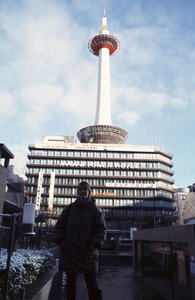 Then we wandered up the road and and, walking by a temple, decided to check it out inside. Although
Kyoto is largely a modern city like any other in Japan, it was also the medieval capital of Japan and
home of the imperial court for much longer and even today is the center for most of Japan's traditional
crafts and industries. So you will find some beautiful old shrines and temples all over Kyoto
surrounded by modern roads and concrete buildings. While the shrines and temples are old, since
they are built of flammable wood, they aren't ancient and many were only built or completed in the
19th century, although many of them were copies of the original buildings that burned down. The
temple that we stumbled upon is apparently one of the largest wooden buildings in Japan, and very
pretty in the early morning sun w/ a light dusting of snow. Mid-morning we walked back to the
tourist bureau and met up w/ two Canadian frends, Dayna and Sara, of SA's who are missionaries/English
teachers in a town east of Osaka. Fortified by the odd can of "Pocari Sweat" we spent the day doing a
walking tour of Kyoto, investigating shrines, temples and gardens (one on the grounds of a hospital)
and (window-)shopping in a six-storey craft mall. Most of the temples were working temples so we
saw the occasional Japanese person making prayers and offerings to the various carved figures
inside the temples and heard the saffron cloaked monks chanting. That was somewhat eerie since the
tune they were chanting was repetitive, somewhat nasal and in a minor key. Also, while outside the
sun was bright inside the temple w/ the doors/walls closed, it was quite dark. Also very
worthwhile was a visit to a craft museum which described the origins and development of many of
the traditional Japanese crafts, most of which seem to have originated in Kyoto and to have some
connection to the "tea ceremony". We had supper in a genuine Japanese restaurant (certainly
none of the staff spoke English) and had a Kyoto specialty of an omelette w/ the works. After a
long day of walking it was a relief to get back on the train for Dayna and Sara's place, which we
all got to eventually after a couple of misunderstandings w/ the schedules. Sleep was welcome
but not long, and after fond farewells at the bus stop early the next morning (next to the egg
vending machine), SA and I made our way back to Kyoto. The highlight of the morning was visiting
the "Silver Temple" and its associated garden which was the main attraction for me. It was a
beautiful garden on the slopes of the mountains that surround Kyoto w/ very old, sculpted trees,
Then we wandered up the road and and, walking by a temple, decided to check it out inside. Although
Kyoto is largely a modern city like any other in Japan, it was also the medieval capital of Japan and
home of the imperial court for much longer and even today is the center for most of Japan's traditional
crafts and industries. So you will find some beautiful old shrines and temples all over Kyoto
surrounded by modern roads and concrete buildings. While the shrines and temples are old, since
they are built of flammable wood, they aren't ancient and many were only built or completed in the
19th century, although many of them were copies of the original buildings that burned down. The
temple that we stumbled upon is apparently one of the largest wooden buildings in Japan, and very
pretty in the early morning sun w/ a light dusting of snow. Mid-morning we walked back to the
tourist bureau and met up w/ two Canadian frends, Dayna and Sara, of SA's who are missionaries/English
teachers in a town east of Osaka. Fortified by the odd can of "Pocari Sweat" we spent the day doing a
walking tour of Kyoto, investigating shrines, temples and gardens (one on the grounds of a hospital)
and (window-)shopping in a six-storey craft mall. Most of the temples were working temples so we
saw the occasional Japanese person making prayers and offerings to the various carved figures
inside the temples and heard the saffron cloaked monks chanting. That was somewhat eerie since the
tune they were chanting was repetitive, somewhat nasal and in a minor key. Also, while outside the
sun was bright inside the temple w/ the doors/walls closed, it was quite dark. Also very
worthwhile was a visit to a craft museum which described the origins and development of many of
the traditional Japanese crafts, most of which seem to have originated in Kyoto and to have some
connection to the "tea ceremony". We had supper in a genuine Japanese restaurant (certainly
none of the staff spoke English) and had a Kyoto specialty of an omelette w/ the works. After a
long day of walking it was a relief to get back on the train for Dayna and Sara's place, which we
all got to eventually after a couple of misunderstandings w/ the schedules. Sleep was welcome
but not long, and after fond farewells at the bus stop early the next morning (next to the egg
vending machine), SA and I made our way back to Kyoto. The highlight of the morning was visiting
the "Silver Temple" and its associated garden which was the main attraction for me. It was a
beautiful garden on the slopes of the mountains that surround Kyoto w/ very old, sculpted trees,
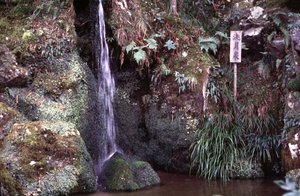 raked gravel "lawns" and a little waterfall that fed several ponds filled w/ carp. After lunch at
McDonalds--which while not very healthy provided a welcome antidote to culture shock--we went to the
modern art museum that boasts a fine collection of ceramic bowls and plates. Nothing to write home
about really... SA tried her luck again at the regular art museum next door (which was apparently
more worthwhile) but I opted to walk back to the train station through the older part of Kyoto and,
besides the ubiquitous shrines and temples, was treated to the sight of many older, more traditional
Japanese homes, usually made of wood. Despite the lack of space, the Japanese have a genius for
creating a sense of private space immediately inside the street and many of their homes had tiny
gardens just outside the door that were very distinctive and welcoming.
raked gravel "lawns" and a little waterfall that fed several ponds filled w/ carp. After lunch at
McDonalds--which while not very healthy provided a welcome antidote to culture shock--we went to the
modern art museum that boasts a fine collection of ceramic bowls and plates. Nothing to write home
about really... SA tried her luck again at the regular art museum next door (which was apparently
more worthwhile) but I opted to walk back to the train station through the older part of Kyoto and,
besides the ubiquitous shrines and temples, was treated to the sight of many older, more traditional
Japanese homes, usually made of wood. Despite the lack of space, the Japanese have a genius for
creating a sense of private space immediately inside the street and many of their homes had tiny
gardens just outside the door that were very distinctive and welcoming.
Reunited at the station SA and I made our way to Osaka where we were met by a 29 year-old Japanese
girl, Reiko, that SA had met at Christmas, who had lived for several months in Vancouver. Her sister
treated us to supper featuring an Osaka specialty of octopus balls which were made right in front of
us in a kind of waffle iron. They were surprisingly good, but you had to remember to let them cool
before biting into them... We slept at Reiko's parents' house, the first "real" Japanese home I had
been in which was a real education in itself. Instead of sitting around a blazing fire on a cold
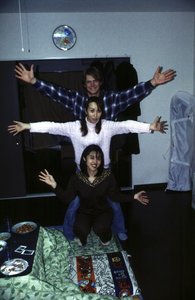 winter's night, the Japanese sit cross-legged around a small, square, wooden table w/ a heater
underneath it and heavy drapes down the sides to keep the hot air from escaping. The idea is to
get your legs under the table (mine got a little stiff after a while) and get them toasty warm.
And when you go to bed, be sure to turn off the heater. Straw mats, wooden table and walls, and
curtains all add up to a serious fire hazard. Next morning after a traditional Japanese breakfast
of rice (basic to any meal, really), fish soup and a VERY sour plum, the Reiko family went off to
work while SA and I got on the train again (you should see a theme developing) to explore downtown Osaka.
winter's night, the Japanese sit cross-legged around a small, square, wooden table w/ a heater
underneath it and heavy drapes down the sides to keep the hot air from escaping. The idea is to
get your legs under the table (mine got a little stiff after a while) and get them toasty warm.
And when you go to bed, be sure to turn off the heater. Straw mats, wooden table and walls, and
curtains all add up to a serious fire hazard. Next morning after a traditional Japanese breakfast
of rice (basic to any meal, really), fish soup and a VERY sour plum, the Reiko family went off to
work while SA and I got on the train again (you should see a theme developing) to explore downtown Osaka.
Osaka is Japan's second biggest economic center after Tokyo and is predicted to overtake Tokyo in
the event that Tokyo is levelled in a (long overdue) killer quake... Basically it's a very big,
very crowded. Its highway literally is high, and is essentially a bridge through the city, at one
point going right through a high-rise building. First stop for us was Osaka's "America town"
which is where the Disney store and all things "American" (except Americans--a couple of Canadians
had to do) are in Osaka. Think of it as Osaka's "club zone" so naturally it was a little sleepy
during to the day but SA soon found a seemingly endless covered arcade where she shopped and I
tagged along for the rest of the day. There were some great bargains to be had in the "100 yen
store" (i.e., the Japanese dollar store). Towards evening the neon lights came on and brightened
things up. There was a whole street of restaurants by the canal vying for our attention, w/ giant
mechanical crabs amongst other gimmics.
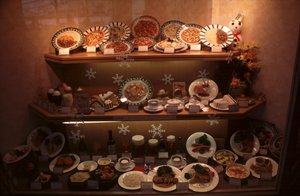 (An aside: many Japanese restaurants will have a display
in their front windows of amazingly realistic plastic replicas of the dishes that they serve. The
replicas often look more appetizing than the real thing and are very handy for the tourist whose
Japanese is limited. On more than one occasion we ordered our meal by pointing to the plastic
replica of the dish that we wanted.) For supper Reiko treated us to a sushi restaurant, but this
was a sushi restaurant w/ a twist: the sushi came by our table on what was essentially an endlessly
revolving conveyor belt. If a plate of sushi came by that took your fancy, you simply took the
plate off the belt. You pay for the meal when you're done by paying Y100/plate, so we added to our
crockery collection and saved on our wallets by taking some of the plates home in our knapsacks.
Just kidding. Still, it was good fun and food, and all the more interesting when you can tell
exactly how much your neighbours are eating. After saying goodbye to Reiko and her parents on
Saturday morning, SA and I got on the long train ride back to Hagi, getting back at about 9:30
that evening, where it was good to see my cousin Pat, back from his visit to the States. En route,
(An aside: many Japanese restaurants will have a display
in their front windows of amazingly realistic plastic replicas of the dishes that they serve. The
replicas often look more appetizing than the real thing and are very handy for the tourist whose
Japanese is limited. On more than one occasion we ordered our meal by pointing to the plastic
replica of the dish that we wanted.) For supper Reiko treated us to a sushi restaurant, but this
was a sushi restaurant w/ a twist: the sushi came by our table on what was essentially an endlessly
revolving conveyor belt. If a plate of sushi came by that took your fancy, you simply took the
plate off the belt. You pay for the meal when you're done by paying Y100/plate, so we added to our
crockery collection and saved on our wallets by taking some of the plates home in our knapsacks.
Just kidding. Still, it was good fun and food, and all the more interesting when you can tell
exactly how much your neighbours are eating. After saying goodbye to Reiko and her parents on
Saturday morning, SA and I got on the long train ride back to Hagi, getting back at about 9:30
that evening, where it was good to see my cousin Pat, back from his visit to the States. En route,
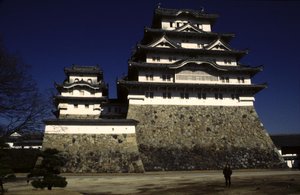 though, we stopped of for a couple of hours in Himeji, home of the most famous and impressive
castle in Japan. And it was. Dubbed the "White Castle", because its walls are--surprise--white,
the massive castle, surrounded by acres of grounds and a moat, is imposingly situated at the top
of a hill hundreds of feet above the town. Unfortunately our visit was rushed since we had a
train to catch, but it was a treat to be able to visit Japan's largest original castle. (Osaka's
castle is a concrete replica of the original that--no surprise--burned down.) The daylight trip
back to Hagi was interesting since we saw some pretty coastal and mountain scenery and passed through
some famous cities, notably Hiroshima, where unfortunately we didn't have time to visit the
A-bomb museum. Still, it impressed upon me how crowded Japan really is. Since it is so moutainous,
they have to build very densely where there is any relatively flat land. Where any hillsides
overlooking this land look like they might misbehave by sliding down, they are draped in concrete.
No exaggeration.
though, we stopped of for a couple of hours in Himeji, home of the most famous and impressive
castle in Japan. And it was. Dubbed the "White Castle", because its walls are--surprise--white,
the massive castle, surrounded by acres of grounds and a moat, is imposingly situated at the top
of a hill hundreds of feet above the town. Unfortunately our visit was rushed since we had a
train to catch, but it was a treat to be able to visit Japan's largest original castle. (Osaka's
castle is a concrete replica of the original that--no surprise--burned down.) The daylight trip
back to Hagi was interesting since we saw some pretty coastal and mountain scenery and passed through
some famous cities, notably Hiroshima, where unfortunately we didn't have time to visit the
A-bomb museum. Still, it impressed upon me how crowded Japan really is. Since it is so moutainous,
they have to build very densely where there is any relatively flat land. Where any hillsides
overlooking this land look like they might misbehave by sliding down, they are draped in concrete.
No exaggeration.
On Sunday morning we went to a local high school where we were introduced to 32 Japanese junior high kids who wanted to practice their English on us. My cousin Pat and I were teamed up w/ a group of two boys and two girls. We started off w/ introductions ("My name is John, and I am very happy to be here today..."--slowly and w/ precise enunciation) and then to an assembly in the gym where we warmed our vocal chords w/ a rousing rendition, in English, of all seven verses of "The Farmer in the Dell" and "If You Wish Upon a Star" led by the local UNESCO representive, who had a surprisingly good voice. Remember, these are high school kids singing these songs. I tried to keep a straight face. Japan is sometimes bizarre. I then warmed up my socks (no shoes inside, remember, and the slipper don't fit me) in a good game of dodge-ball. After that it was back to the classroom for English conversation practice ("What is your name?" "Ahhh?" "W-h-a-t i-s y-o-u-r n-a-m-e?" "Ah! M-y n-a-m-e i-s Aya." etc.) Actually, the kids' English was surprisingly good; certainly my Japanese is pitiful in comparison. Then lunch (where Pat and I were a bad influence by instigating wars w/ the rubber bands from our packed lunch containers), a walk around the town to find the answers to various questions ("Is Sydney the capital of Australia?" "No." (Canberra is.)). Our team won, but they didn't say that the instructors couldn't answer the questions. Then back to the school for more games, including the famous "gesture game". I think that our team's rendition of a firing squad was a little controversial. ("Hunting?") Then closing ceremonies, fond farewells, and a discretely handed envelope containing Y10,000 (~$150) as thanks for our "kind help and wise guidance". Yeah. It was a fun day and a good chance to see the typical Japanese junior high school kid in the wild. They really are as polite and well-behaved as the legends say.
Sunday evening SA's Hagi friend, Asami, who has also lived in Canada, and works part-time as a translator, had invited us out for supper. When she arrived to pick us up she announced that she and SA were going on a blind date--and I was welcome to tag along since Pat and Holly et al had already left for an engagement of their own. Needless to say I felt a little uncomfortable as we drove to our destination, sittingly sullenly in the back seat (I mean, the least Asami could have done was set me up w/ one of her cute Japanese girlfriends) with SA, now blind-folded, and Asami giggling in the front seat. I became a little suspicious when we drove to a residential area and pulled up in the driveway of a big house. My suspicions were confirmed when, upon entering the house I saw Pat and Holly, the Ichiharas, Dan and Danika and others of SA's Hagi friends, some cute female ones among them. When I pulled off her blindfold SA was momentarily confused wondering which one was her blind date, but as recognition returned she screamed in delight. So we all sat down to Mrs. Ichihara's famous cooking w/ good conversation finished off by a sing-song and prayers of thanksgiving for SA's arrival in Hagi and her soon return. A great way to end my time in Japan. Early the next morning I caught the bus to Ogori, took the shinkansen to Fukuoka, and the subway to the airport, whereupon I boarded my flight for Hong Kong, Sydney and now, Cairns.
Well, I'd best be signing off. No promises as to when my next letter will be, but expect three to five weeks.
Until then,
John